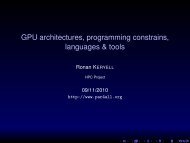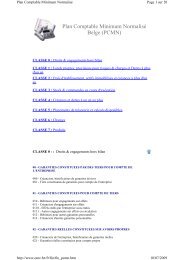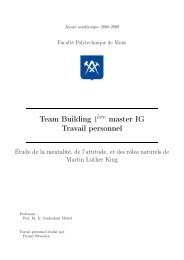An Ontology for Video Human Movement Representation based on ...
An Ontology for Video Human Movement Representation based on ...
An Ontology for Video Human Movement Representation based on ...
You also want an ePaper? Increase the reach of your titles
YUMPU automatically turns print PDFs into web optimized ePapers that Google loves.
parts of the body. Complex movement is a series of simplemovement and acti<strong>on</strong>s taking place over a period of time.Simple movement can also be divided into three kinds ofmovement: 1) Hand<str<strong>on</strong>g>Movement</str<strong>on</strong>g>, when the body part of amovement uses <strong>on</strong>ly Lefthand or RightHand elements. 2)Foot<str<strong>on</strong>g>Movement</str<strong>on</strong>g> when it uses <strong>on</strong>ly feet elements. 3)HandFeet<str<strong>on</strong>g>Movement</str<strong>on</strong>g>, which is <str<strong>on</strong>g>based</str<strong>on</strong>g> <strong>on</strong> the movement of handsand feet elements together.Figure 4. Part of the <strong>on</strong>tology related to different kinds of movement.Both c<strong>on</strong>cepts and c<strong>on</strong>cept instances (individuals) aredefined using OWL, which is c<strong>on</strong>sidered as standard languageto represent knowledge and to facilitate exchanges and linksbetween <strong>on</strong>tologies.TABLE I.DESCRIPTION GLOSSARYFigure 3. Part of the <strong>on</strong>tology related to movement representati<strong>on</strong> <str<strong>on</strong>g>based</str<strong>on</strong>g> <strong>on</strong>Benesh notati<strong>on</strong>We also developed Descriptors, which are used to annotatethe measurements of a movement, such as, the Distancebetween the different body parts, and the time <str<strong>on</strong>g>for</str<strong>on</strong>g> modeling thekeypose Durati<strong>on</strong> in the sequences. We presented the differentmovement Acti<strong>on</strong>s by using the c<strong>on</strong>cepts (move, raise, etc.). aspictured <strong>on</strong> Figure 4.Now, we can define the glossary of the VMO. This glossarywill describe the most relevant c<strong>on</strong>cepts, and it is summarizedin Table I. In fact, visual data is included in our <strong>on</strong>tology asindividuals applied <strong>on</strong> the c<strong>on</strong>cepts. Each individual includes:object identifier, time label, c<strong>on</strong>tent descriptors and link to theraw data (the keypose in the repository).C<strong>on</strong>cept<str<strong>on</strong>g>Movement</str<strong>on</strong>g>Body-<str<strong>on</strong>g>Movement</str<strong>on</strong>g>BodyPartStaveLinesHeadLineShouldersLineWaistLineKneesLineFeetLineBasicSignInFr<strong>on</strong>tOfLevelBehindPlaneSagittalCor<strong>on</strong>alTransverseDefiniti<strong>on</strong>A way of putting body parts together to <str<strong>on</strong>g>for</str<strong>on</strong>g>m ahigher-level movementIt is the blocks of a body part that tells what eachpart should do at a specific point in time. TheBody-<str<strong>on</strong>g>Movement</str<strong>on</strong>g> element is the basic class <str<strong>on</strong>g>for</str<strong>on</strong>g> allmovementsC<strong>on</strong>tains <strong>on</strong>e ore more areas of the body that areaffected by the movement. It has two elements(part-name, side)Each stave line describes a number of static bodypositi<strong>on</strong>Height of the top of the headHeight of the shouldersHeight of the waistHeight of the kneesRepresents the floor lineRepresents the positi<strong>on</strong> of the hands and feet,relative to the body. It has three signs values (infr<strong>on</strong>t,level, and behind)The positi<strong>on</strong> of body part is in the fr<strong>on</strong>t of the bodywallPositi<strong>on</strong> of body part is within the body wallPositi<strong>on</strong> of body part is behind the body wallUsed to describe the anatomic positi<strong>on</strong> of the body.It has three values: sagittal, cor<strong>on</strong>al, and transverse<str<strong>on</strong>g>An</str<strong>on</strong>g>y plane dividing the body vertically into rightand left porti<strong>on</strong>sIt divides the body into fr<strong>on</strong>t and back halvesIt divides the body into top and bottom halves
C<strong>on</strong>ceptDescriptorsDurati<strong>on</strong>Distance<str<strong>on</strong>g>Video</str<strong>on</strong>g>SequencekeyPoseDefiniti<strong>on</strong>Describe the measurements of a movementDescribe the time <str<strong>on</strong>g>for</str<strong>on</strong>g> modeling the keyposedurati<strong>on</strong> in the sequencesRepresents an exact measure of distanceC<strong>on</strong>ssiste of moving images with or without soundC<strong>on</strong>sists of two element (Keypose and durati<strong>on</strong>)Represent the locati<strong>on</strong>s occupied by the fourextremities, the hands and feet, in relati<strong>on</strong> to thebody of the pers<strong>on</strong> <strong>on</strong> the planeC. Formalizati<strong>on</strong>After having studied the c<strong>on</strong>ceptualizati<strong>on</strong> step. We arec<strong>on</strong>tinuing the VMO modeling of our by <str<strong>on</strong>g>for</str<strong>on</strong>g>malizati<strong>on</strong> step.The <strong>on</strong>tology was <str<strong>on</strong>g>for</str<strong>on</strong>g>malized using OWL and Protege.4.1 1 . So,it can be easily reused and shared. Figure 5 shows the hierarchydefined in Protégé.Figure 5. VMO hierarchy in ProtégéTo <str<strong>on</strong>g>for</str<strong>on</strong>g>malize in OWL the compositi<strong>on</strong> of movements (usedin Figure 3 and 4 respectively), we exploit the method definedby [18]. Figure 6 shows the <str<strong>on</strong>g>for</str<strong>on</strong>g>malizati<strong>on</strong> in OWL, which is apart of the <strong>on</strong>tology related to video human movement.Formal expressi<strong>on</strong>s in SWRL (Semantic Web RuleLanguage) were also defined to classify each kind of movementpresented in the Figure 4 (see the SWRL expressi<strong>on</strong>s in Figure9). Those rules are defined by expressing how to infer that aspecific movement is c<strong>on</strong>sidered of a specific type. Forexample, the rule (Hand-Left-Moved-InFr<strong>on</strong>tOf-SagittalPlane)states that a movement named a (<str<strong>on</strong>g>Movement</str<strong>on</strong>g> (?a)), is classifiedas a simple movement which is a (Hand-Left-Moved-InFr<strong>on</strong>tOf-SagittalPlane (?a)), since it has a body part named(Hand(?y) ∧ hasPart(?a, ?y) ∧ hasSide(?y, Left) ∧Actios(Move) ∧ Sagittal(?z) ∧ hasPlane(?a, ?z) ). In this rule,the c<strong>on</strong>cepts are (<str<strong>on</strong>g>Movement</str<strong>on</strong>g>, Hand, Acti<strong>on</strong>s, and Sagittal), andthe relati<strong>on</strong>s between c<strong>on</strong>cepts are (hasPart, hasSide andhasPlane).111111…….Figure 6. OWL code <str<strong>on</strong>g>for</str<strong>on</strong>g> the <str<strong>on</strong>g>for</str<strong>on</strong>g>malizati<strong>on</strong> of movement part of VMO .IV.EXPERIMENTAL RESULTSFormalizati<strong>on</strong> of <str<strong>on</strong>g>Movement</str<strong>on</strong>g> ClassTo validate our VMO, we create several instances <str<strong>on</strong>g>based</str<strong>on</strong>g> <strong>on</strong>real video human movements. For training and evaluati<strong>on</strong> ourpurposes, 10 videos were used, and durati<strong>on</strong> of the data is about2 minutes average per video of the data. We have applied thetemporal segmentati<strong>on</strong> method (background subtracti<strong>on</strong>average) [23], to cut the edge of the human body shape. To findthe keypose images, we have been verified that shapes do notchange their positi<strong>on</strong>s. Then, the low level video features havebeen extracted. Notice that, we have used the OpenCV imageprocessing library (versi<strong>on</strong> (2.3.1)) 2 , in all our implementati<strong>on</strong>steps.Extracted video features are recorded in XML file <str<strong>on</strong>g>for</str<strong>on</strong>g>producing BMN. The keypose is generated automaticallyinvolving text in<str<strong>on</strong>g>for</str<strong>on</strong>g>mati<strong>on</strong>. This test is <str<strong>on</strong>g>based</str<strong>on</strong>g> <strong>on</strong> the keyposenumber, the time element (durati<strong>on</strong>), the in<str<strong>on</strong>g>for</str<strong>on</strong>g>mati<strong>on</strong> (part,1 http://protege.stan<str<strong>on</strong>g>for</str<strong>on</strong>g>d.edu2 http://source<str<strong>on</strong>g>for</str<strong>on</strong>g>ge.net/projects/opencvlibrary
side), and BMN in<str<strong>on</strong>g>for</str<strong>on</strong>g>mati<strong>on</strong> (plane, positi<strong>on</strong>, and distance) .<str<strong>on</strong>g>An</str<strong>on</strong>g>example of a keypose in XML <str<strong>on</strong>g>for</str<strong>on</strong>g>mat is given at Figure 7:< sequence total key pose = ''3'' durati<strong>on</strong> =''6,9''>1 footline11 footline11 kneeline11 kneeline1Figure 7. XML movement representati<strong>on</strong>.During <strong>on</strong>tology instantiati<strong>on</strong>, we verified that all c<strong>on</strong>ceptswere used and all required in<str<strong>on</strong>g>for</str<strong>on</strong>g>mati<strong>on</strong> <str<strong>on</strong>g>for</str<strong>on</strong>g> supporting themovement annotati<strong>on</strong> <str<strong>on</strong>g>based</str<strong>on</strong>g> BMN was represented. In fact, anumber of SWRL rules were created, as shown in the Figure 9.Each SWRL rule was c<strong>on</strong>structed by using SWRLtab 1 , andwhich is a Protégé plug-in. The aim of inference is to derivethe new knowledge by applying the rules <strong>on</strong> the existingknowledge in a specific domain. Currently, various ruleengines <str<strong>on</strong>g>for</str<strong>on</strong>g> OWL reas<strong>on</strong>ing have been proposed [9,15]. Weuse ‘Jess’ rule engine 2 , which integrated in Protégé, <str<strong>on</strong>g>for</str<strong>on</strong>g>reas<strong>on</strong>ing and executi<strong>on</strong> the SWRL rules.The key idea <str<strong>on</strong>g>for</str<strong>on</strong>g> detecti<strong>on</strong> of the semantic inference rules is<str<strong>on</strong>g>based</str<strong>on</strong>g> <strong>on</strong> the mappings between the visual features of videomovement presented in XML fragments, and <strong>on</strong>tology(c<strong>on</strong>cepts and rules). Figure 8, <strong>on</strong> the upper left side, shows theXML code that corresp<strong>on</strong>ds to the key pose image <strong>on</strong> theupper right side and its SWRL rule (bottom side).We annotate all our movements by defining the compositi<strong>on</strong>of movement c<strong>on</strong>cepts, properties, and the relati<strong>on</strong>s betweenthose c<strong>on</strong>cepts. Then, we specify the inference rules that let usdraw c<strong>on</strong>clusi<strong>on</strong>s from what we recognize in the data (XMLfile). All this in<str<strong>on</strong>g>for</str<strong>on</strong>g>mati<strong>on</strong> is exploited to create severalinstances in the VMO. Afterwards, the system runs inferenceengine from Protégé. As a result the inferred movements areproposed <str<strong>on</strong>g>for</str<strong>on</strong>g> annotating video human movement. Figure 9illustrates the use of the VMO and the movement rules. Inorder to facilitate the definiti<strong>on</strong> of those rules, several instancesof the movement c<strong>on</strong>cept have been created in our <strong>on</strong>tology.Preliminary results have shown a good adequacy betweenour approach <str<strong>on</strong>g>for</str<strong>on</strong>g> semantic annotati<strong>on</strong> and human interpretati<strong>on</strong>.However, we have still to c<strong>on</strong>duct larger experiments toquantify our method.< sequence total key pose = ''5'' durati<strong>on</strong> =''8,21''>1 footline11 footline11 ShoulderLine 31 ShoulderLine3<str<strong>on</strong>g>Movement</str<strong>on</strong>g> (?a) ∧ Hand(?y) ∧ hasPart(?a, ?y) ∧ hasSide(?y, Left) ∧Hand(?x) ∧ hasPart(?a, ?x) ∧ hasSide(?x, Right) ∧ Actios(Move) ∧hasDirecti<strong>on</strong>(?a, horiz<strong>on</strong>tal) ∧ Cor<strong>on</strong>al(?z) ∧ hasPlane(?a, ?z) →Hands-Moved-Horiz<strong>on</strong>tally-PlaneFr<strong>on</strong>tal(?a)Figure 8. XML and SWRL movement representati<strong>on</strong>.V. CONCLUSION AND FUTURE WORKIn this paper, we presented a VMO defined from the analysisof the main c<strong>on</strong>cepts of the multi-media domain c<strong>on</strong>sideringand BMN. We aimed to using this <strong>on</strong>tology to automate videomovement annotati<strong>on</strong>. The main c<strong>on</strong>tributi<strong>on</strong> of this paper isthe detailed descripti<strong>on</strong> of the definiti<strong>on</strong> process of a VMO,from the definiti<strong>on</strong> of the c<strong>on</strong>cepts till the specificati<strong>on</strong> and<str<strong>on</strong>g>for</str<strong>on</strong>g>malizati<strong>on</strong> of axioms related to the domain. We describealso how this <strong>on</strong>tology can be used to support video annotati<strong>on</strong>and retrieval by the inference of the axioms defined in the<strong>on</strong>tology. We collected the instances of the c<strong>on</strong>cepts from lowlevelvideo data, which were recorded in XML file <str<strong>on</strong>g>based</str<strong>on</strong>g> <strong>on</strong>Benesh <str<strong>on</strong>g>Movement</str<strong>on</strong>g> Notati<strong>on</strong> (BMN).We are now working to applying our proposal to develop aquery system that automatically captures the instances fromdifferent XML file, and to analyze the different possibilities ofcomplex movements inferences that we can get by using this<strong>on</strong>tology. Further validati<strong>on</strong>s have to be carried out to verifythe adequacy between our VMO approach and humanpercepti<strong>on</strong>. We will also include the evoluti<strong>on</strong> of the VMO withother kind of movement’s types (Dance, Sport, etc.).1 http://protegewiki.stan<str<strong>on</strong>g>for</str<strong>on</strong>g>d.edu/wiki/SWRLTab2 http://www.jessrules.com/






